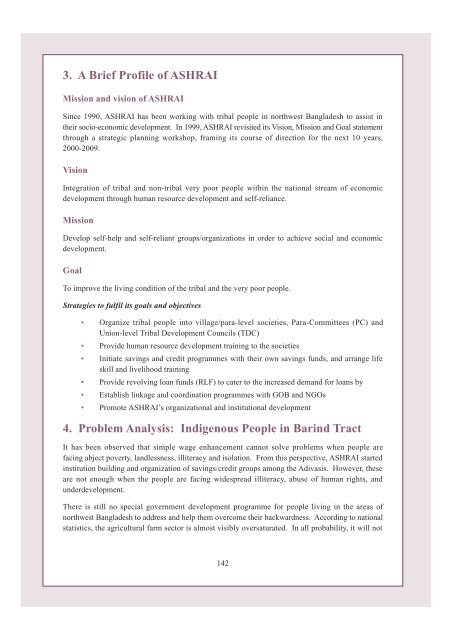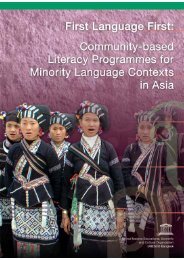Part II.pdf - MTB-MLE Network
Part II.pdf - MTB-MLE Network
Part II.pdf - MTB-MLE Network
You also want an ePaper? Increase the reach of your titles
YUMPU automatically turns print PDFs into web optimized ePapers that Google loves.
3. A Brief Profile of ASHRAI<br />
Mission and vision of ASHRAI<br />
Since 1990, ASHRAI has been working with tribal people in northwest Bangladesh to assist in<br />
their socio-economic development. In 1999, ASHRAI revisited its Vision, Mission and Goal statement<br />
through a strategic planning workshop, framing its course of direction for the next 10 years,<br />
2000-2009.<br />
Vision<br />
Integration of tribal and non-tribal very poor people within the national stream of economic<br />
development through human resource development and self-reliance.<br />
Mission<br />
Develop self-help and self-reliant groups/organizations in order to achieve social and economic<br />
development.<br />
Goal<br />
To improve the living condition of the tribal and the very poor people.<br />
Strategies to fulfil its goals and objectives<br />
• Organize tribal people into village/para-level societies, Para-Committees (PC) and<br />
Union-level Tribal Development Councils (TDC)<br />
• Provide human resource development training to the societies<br />
• Initiate savings and credit programmes with their own savings funds, and arrange life<br />
skill and livelihood training<br />
• Provide revolving loan funds (RLF) to cater to the increased demand for loans by<br />
• Establish linkage and coordination programmes with GOB and NGOs<br />
• Promote ASHRAI’s organizational and institutional development<br />
4. Problem Analysis: Indigenous People in Barind Tract<br />
It has been observed that simple wage enhancement cannot solve problems when people are<br />
facing abject poverty, landlessness, illiteracy and isolation. From this perspective, ASHRAI started<br />
institution building and organization of savings/credit groups among the Adivasis. However, these<br />
are not enough when the people are facing widespread illiteracy, abuse of human rights, and<br />
underdevelopment.<br />
There is still no special government development programme for people living in the areas of<br />
northwest Bangladesh to address and help them overcome their backwardness. According to national<br />
statistics, the agricultural farm sector is almost visibly oversaturated. In all probability, it will not<br />
142
















